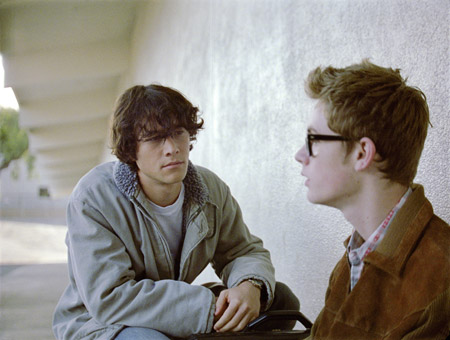Brick
 “Brick” has every reason to be pretentious. I didn’t realize this going in, and for the first fifteen minutes I felt like I was watching a bad film school rehash of Godard in the most contrived manner. But somewhere along the way, this flagrantly self-affected and at times dementedly jocular piece of art-house trash earned my…
“Brick” has every reason to be pretentious. I didn’t realize this going in, and for the first fifteen minutes I felt like I was watching a bad film school rehash of Godard in the most contrived manner. But somewhere along the way, this flagrantly self-affected and at times dementedly jocular piece of art-house trash earned my…

a Focus Features release. Photo by Steve Yedlin.
“Brick” has every reason to be pretentious. I didn’t realize this going in, and for the first fifteen minutes I felt like I was watching a bad film school rehash of Godard in the most contrived manner. But somewhere along the way, this flagrantly self-affected and at times dementedly jocular piece of art-house trash earned my respect.
Yes, I do think that neorealist films are superior by design, and I have my reasons for believing that. But “Brick,” written and directed by Rian Johnson, requires dissection in layers. At first, much of the dialogue makes no sense. The characters are all speaking in a slang dialect for which you, the viewer, have no key. So, trying to follow the film through the dialogue doesn’t work… at least not right away.
So I found myself shifting to images. I tend to think visually, so I tried to process information by interpreting the story by what I saw from scene to scene. In that way the story begins to make some sense, but I find myself yet annoyed by the sometimes cacophonous jumbling of images that doesn’t follow strict narrative. But trust me, readers, the story has a center; it just doesn’t know it has one.
Brendan Frye (Joseph Gordon-Levitt) is attempting to solve a mystery: The disappearance of Emily Kostach (Emilie de Ravin), a girl in whom Brendan had considerable romantic interest. We infer the feeling wasn’t mutual. Two days prior to finding her body, Brendan answers a call from her at a payphone near a street intersection. Emily, sounding frantic, tells Brendan she screwed up. Why? How? About what? Before these questions can be answered, a black muscle car flies by.
Brendan enlists the aid of his friend, The Brain (Matt O’Leary), to piece together exactly what went down. He finds an invite to a party, but that seems more of a dead end than a hand-scribbled note with a symbol that looks like an “A” but actually denotes a visual landmark—it makes sense when you see it.
And that’s the interesting thing, the way the story elements finally come together seems improbable at first but surprisingly rational by the time the story reaches the mid-point. You’re no longer wondering who the Pin (Lukas Haas), short for “kingpin”, is… you know he’s the caped nerd who uses a cane with a brass duck’s head for a handle, is chauffered around in the back of a minivan, and offices out of his mom’s basement.
There’s also Dode (Noah Segan), a punk who has no other home of note, save a dumpster at which he seems to have taken up permanent residence; you’ll notice something’s gone seriously wrong when Brendan turns up later to find the dumpster sans Dode. Tugger (Noah Fleiss) is the Pin’s hired muscle. We’re introduced to him in a surreal sequence in which Brendan discover’s Tug’s connection to this bizarre series of events. Brendan’s intelligence manages to trump brawn on several occasions, but on initially encountering Tug, he finds he may be in well over his head. Tug is unstable to a fault, but turns out to have a rational side… sometimes.
While the technique and the dialogue can be distracting and, in certain scenes, sell this film just short of brilliance, I found it impossible to not be seduced by the unfolding plot. If the film had taken itself entirely seriously, it wouldn’t have worked at all.
Consider, for example, two young girls trying desperately to come off as noir seductresses, Laura (Nora Zoehtner) and Kara (Meagan Good). Their air of pretense seems to fit the initial tone of the film, but when the film changes pitch, and thus shifts your perspective on the world you’re looking into, it makes their affectations misplaced—and telling.
And the “Brick” itself? It’s more or less the MacGuffin. It has its own story, but one that is immaterial relative to what it causes the characters to do to one another. It facilitates the main plot, concerning Emily and Brendan, as well as the motivation to want to understand what’s going on in it.
This may all appear rather surreal, and for many good reasons. However, I attest to the fact that I actually have seen, on more than one occasion, a caped, cane-wielding young man traversing the walking trails at the nearby park. Absurd? Certainly seems so. But let’s not forget that teenagers often do create their own realities in which they fashion themselves as Tuggers, Pins, Dodes and, usually, there’s at least one Brendan.
But who they are and how they seem isn’t nearly as crucial as where they are and what they’re doing at any given time and, most importantly, how the film challenges your intelligence by requiring you to think consciously and persistently about these connections if you’re to make any sense of the story at all. Tilt your head in that direction, and the entire film will make more sense than most films you’ve seen this year.
 Brick • Dolby® Digital surround sound in select theatres • Aspect Ratio: 1.85:1 • Running Time: 110 minutes • MPAA Rating: R for violent and drug content. • Distributed by Focus Features
Brick • Dolby® Digital surround sound in select theatres • Aspect Ratio: 1.85:1 • Running Time: 110 minutes • MPAA Rating: R for violent and drug content. • Distributed by Focus Features